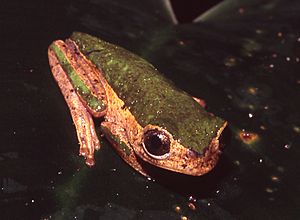Pithecopus palliatus facts for kids
Quick facts for kids Pithecopus palliatus |
|
|---|---|
 |
|
| Conservation status | |
| Scientific classification | |
| Synonyms | |
|
The Pithecopus palliatus is a fascinating type of frog that lives in the forests of South America. It's also known as the Pithecopus palliatus or sometimes the Phyllomedusa palliata. This frog belongs to a group of tree frogs called Phyllomedusinae, which are known for their unique climbing abilities.
You can find this special frog in several countries, including Bolivia, Brazil, Ecuador, and Peru. It might even live in Colombia too! These frogs prefer to live in warm, wet places like lowland forests. They also like areas with freshwater marshes that might dry up sometimes.
Sadly, the Pithecopus palliatus is facing a challenge. Its home, or habitat, is shrinking because of human activities. This means there are fewer safe places for these frogs to live and thrive. Scientists are working to understand and protect these amazing creatures.
Contents
What is the Pithecopus Palliatus?
The Pithecopus palliatus is a species of tree frog. It was first described by a scientist named Wilhelm Peters in 1873. These frogs are part of the family Hylidae, which includes many different types of tree frogs. Within this family, they belong to the subfamily Phyllomedusinae. Frogs in this group are often called "leaf frogs" or "monkey frogs" because of how they move. They can grasp branches with their hands and feet, almost like monkeys!
Where Does This Frog Live?
The Pithecopus palliatus is found in the Amazon rainforest region of South America. Its known range includes parts of:
- Bolivia
- Brazil
- Ecuador
- Peru
Scientists believe it might also be found in Colombia, but more research is needed to confirm this.
What Kind of Home Does it Need?
This frog lives in specific types of environments. It prefers:
- Subtropical or tropical moist lowland forests: These are warm, wet forests that are not very high above sea level. They have lots of trees and plants.
- Intermittent freshwater marshes: These are wet, swampy areas that have fresh water. "Intermittent" means they might dry up during certain times of the year and then fill with water again. These areas are important for the frog's life cycle, especially for laying eggs.
Why is the Pithecopus Palliatus Important?
Every species, including the Pithecopus palliatus, plays a role in its ecosystem. Frogs are often considered "bioindicators." This means that their health can tell us about the health of the environment around them. If frog populations are struggling, it can be a sign that something is wrong with the air, water, or land.
What Threats Does it Face?
The main threat to the Pithecopus palliatus is habitat loss. This happens when the places where animals live are destroyed or changed. For this frog, habitat loss can be caused by:
- Deforestation: Cutting down trees for farming, logging, or building.
- Pollution: Chemicals and waste getting into the water and land.
- Climate change: Changes in weather patterns that affect their wet habitats.
When their habitat is lost, these frogs lose their homes, their food sources, and places to lay their eggs. This makes it harder for them to survive and reproduce.
Protecting the Pithecopus Palliatus
Scientists and conservation groups are working to protect the Pithecopus palliatus and its habitat. This includes:
- Protecting forests: Setting aside areas of the Amazon rainforest as national parks or reserves.
- Sustainable practices: Encouraging ways of farming and living that do not harm the environment.
- Research: Learning more about these frogs to understand their needs and how best to help them.
By understanding and protecting species like the Pithecopus palliatus, we can help keep our planet healthy for all living things.
See also
 In Spanish: Pithecopus palliatus para niños
In Spanish: Pithecopus palliatus para niños


